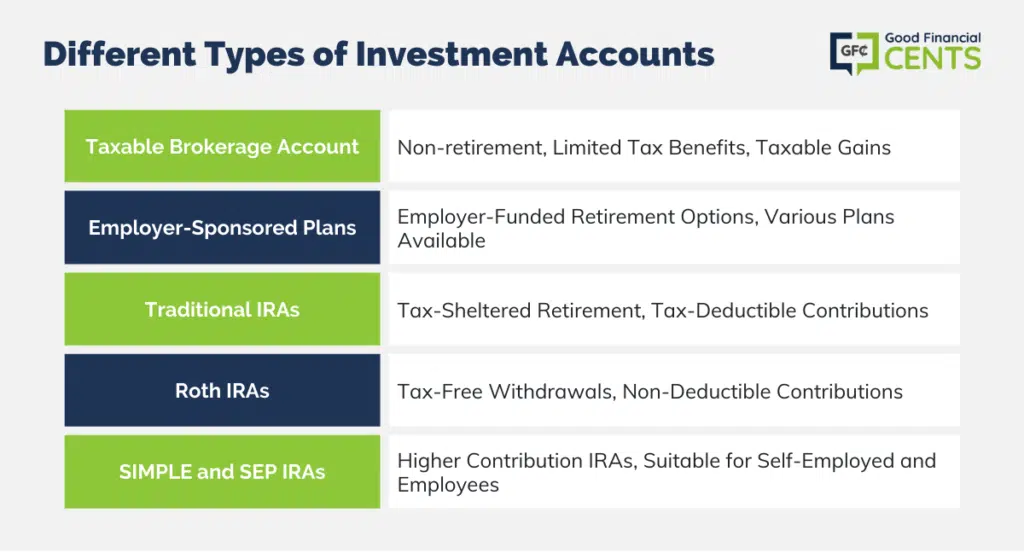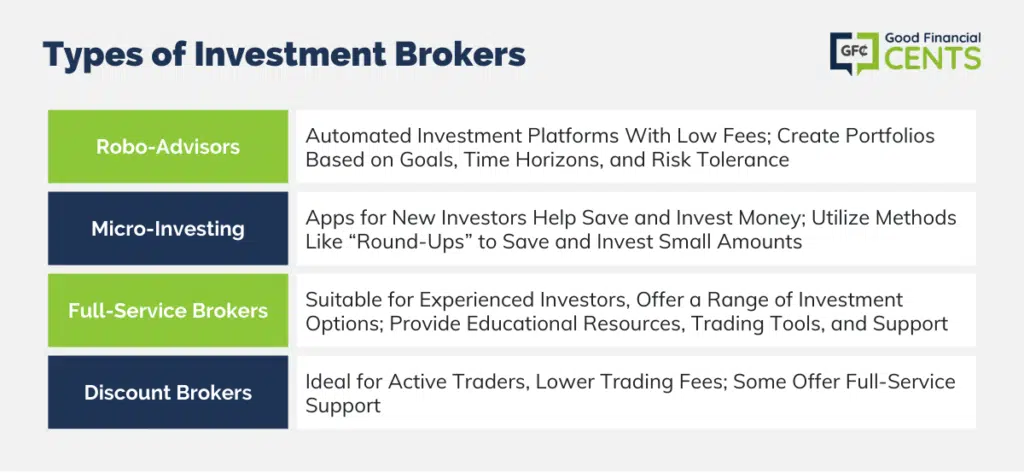If you’re new to investing, the process can be a bit confusing. Which type of investment account types should you choose, and what type of brokerage should use for that account?
Sometimes you don’t have a choice with either. A good example is an employer-sponsored retirement plan. The employer not only chooses the plan but also the investment company where your account will be held.
But the situation is more complicated with other types of accounts. Since those are primarily self-directed accounts, you’ll need to make decisions as to what type of plan you want and which investment broker you’ll hold it at.
We’ll cover the different investment accounts first, then the various types of investment brokers next.
Table of Contents
Quick Guide to the Types of Investment Accounts
- Taxable Brokerage Accounts
- Employer-Sponsored Retirement Plans
- Traditional and Roth IRAs
- SIMPLE and SEP IRAs
- Best Brokers to Hold Your Investment Account
The Different Types of Investment Accounts You Can Open and Why
There are two basic types of investment accounts: taxable and tax-deferred.
A taxable account is one that you will have available to both contribute to and make withdrawals from at your own option. You can also choose what type of investment broker will hold the account. And once opened, you can choose and manage the investments you’ll make.
Tax-deferred accounts are primarily retirement accounts. There are limits to how much you can contribute to the plan. And since contributions are generally tax-deductible, there will be tax consequences when you make withdrawals.
Unlike taxable investment accounts, which can be used for any purpose and any duration, tax-deferred accounts are primarily designed for retirement purposes.
If you’re looking to open a taxable account or a retirement account that isn’t employer-sponsored, there are several choices as to both plan types and investment brokers.
Taxable Brokerage Accounts
A taxable brokerage account is an account that isn’t a tax-sheltered retirement account. And while you may want to hold the majority of your investments in tax-sheltered plans, it makes sense to have at least some of your investments in a taxable account.
However, taxable accounts offer little in the way of tax benefits. That’s why the majority of your investment portfolio should be held in tax-deferred plans.
Just as the name implies, any investment gains you earn in a taxable brokerage account will be subject to income tax.
However, having a taxable account will give you access to the money in the account without having to incur the taxable distributions that come from early withdrawals from retirement accounts.
That’s because contributions to taxable accounts are not tax-deductible, and taxes are paid on investment gains as they’re earned.
Generally speaking, your investment income will be taxed at your ordinary income tax rates. However, the IRS provides a reduced tax rate on long-term capital gains. These are gains on investments you’ve held for more than one year.
The tax rate on long-term capital gains is between 0% to 20%, with most taxpayers paying 15% or less. For that reason, taxable brokerage accounts are best suited to holding long-term investments.
Taxable brokerage accounts can be open either individually or jointly with your spouse.
Employer–Sponsored Retirement Plans
Many employers, and most large employers, offer sponsored retirement plans for their employees.
The employer sponsors and administers the plan, and you, as the employee, fund it through payroll deductions. In most plans, you’ll also have a choice as to how you invest the money in the account.
There are several different plans offered, including the following:
Though each is a different plan, the general parameters are the same for each. Your contributions to the plan are tax-deductible, and your employer may offer a matching contribution.
Many also come with a loan provision. If so, you can borrow up to 50% of the vested balance in the plan, up to $50,000.
You can contribute up to $23,000 per year or $30,500 if you’re over 50. With employer-matching contributions, total contributions can be as high as $69,000.
Both your contributions to the plan and investment income earned are tax-deferred. Tax will be due on the withdrawals from the plan once you reach retirement age. If you do take distributions before reaching age 59 ½, you’ll also have to pay a 10% early withdrawal penalty tax.
With most plans, the investment trustee will be chosen by your employer. Some plans offer unlimited investment options. Others, like the TSP, allow you to choose only from a small number of funds.
And even though the plans are tied to your employer, they’re generally portable. If you leave one employer, you can either do a rollover of the plan into an IRA or your next employer’s plan if they permit rollovers.
Traditional and Roth IRAs
Individual retirement accounts, or simply IRAs, are tax-sheltered retirement plans for individuals. Just about anyone can have an IRA, as long as you have the earned income to cover the contributions.
For 2025, you can contribute up to $7,000 per year toward an IRA or $8,000 if you’re 50 or older.
Traditional IRAs
For most taxpayers, your contributions will be tax-deductible. In all cases, investment income will be tax-deferred. Similar to employer-sponsored retirement plans, you’ll pay tax on the money as it’s withdrawn from the account.
Once again, if withdrawals are taken before age 59 ½, you’ll also be subject to a 10% early withdrawal penalty tax.
The IRS limits tax-deductibility of traditional IRA contributions based on income limits if you or your spouse are covered by an employer plan. For that reason, contributions to a traditional IRA aren’t always tax deductible.
Roth IRAs
Roth IRAs are similar to traditional IRAs as far as contribution amounts and tax deferral of investment earnings.
The main differences between the two plans are as follows:
- Your contributions to the plan are not tax-deductible.
- You can withdraw your contributions at any time without being subject to either income tax or the 10% early withdrawal penalty.
- Once you reach age 59 ½, and as long as you’ve been in the plan for at least five years, withdrawals can be taken tax-free.
- If you do make withdrawals before turning 59 ½, your accumulated investment earnings will be subject to both ordinary income tax and the 10% early withdrawal penalty. But once again, your contributions will not be subject to tax or the penalty.
Simply put, a Roth IRA is an excellent way to add tax-free income to your retirement plans.
There’s one more major difference between a Roth and a traditional IRA, and that’s eligibility. The IRS imposes income limits beyond which you’re no longer eligible to make a Roth IRA contribution.
But even if you can’t make a Roth IRA contribution, there is a workaround. It’s called a Roth IRA conversion, and it can be used to convert other retirement plans to a Roth IRA.
SIMPLE and SEP IRAs
SIMPLE and SEP IRAs are IRAs, with the main differences being higher contribution amounts, as well as a requirement to be self-employed.
With a SIMPLE IRA, you can contribute up to $16,000 per year, or $19,500 if you’re 50 or older, and there is a provision for an employer match.
For a SEP IRA, you can contribute 25% of your income up to a maximum of $69,000. (NOTE: Due to a complex calculation method, the effective contribution rate for a SEP IRA is really 20%.)
Much like traditional and Roth IRAs, SIMPLE and SEP IRAs are also self-directed. You can choose the investment broker where you hold your account, as well as manage the investments in the account.
As a business owner, you can open a SIMPLE or SEP IRA to your employees. However, since they are IRAs, each employee will maintain a separate account. This is unlike 401(k) plans and other employer-sponsored retirement plans there’s one plan that all employees participate in.

Best Brokers to Hold Your Investment Account
Once you decide what type of investment account you want to open, the next step will be to choose the broker to hold the account.
Fortunately, there are several. You can choose the one that best matches your investment experience and temperament.
Here are the four basic types:
Robo-Advisors – Automated Online Investment Platforms
Robo-advisors handle the job of managing your investments for you completely, and they do it at a surprisingly low fee. That includes creating your portfolio based on your goals, time horizon, and risk tolerance.
Your portfolio will include a mix of stocks and bonds, and some robo-advisors will also add real estate and natural resources.
The investments are typically held in exchange-traded funds (ETFs) rather than individual securities. They’ll even reinvest dividends earned and rebalance your portfolio as necessary.
For example, Betterment provides complete management of your portfolio for an annual fee ranging between 0.25% and 0.40%. And since there’s no minimum initial investment required, it’s a good choice even for new investors.
Wealthfront works much the same way, but it has a minimum initial investment requirement of $500 and charges a fee of 0.25%.
At that rate, you can have $10,000 professionally managed for just $25 per year or $100,000 at $250 per year. Or even $1 million managed for just $2,500 per year.
Micro-Investing App for Beginning Investors
If you’re a new investor and having difficulty accumulating the money you need to begin, there are micro-investing apps. They not only invest your money – robo-advisor style – but also help you to save it in the first place.
For example, an app known as Acorns uses a method called “round-ups” to help you save up the money to invest. You link the Acorns app to a spending account, and it rounds up purchases, saving the difference for savings and ultimately investing.
Let’s say you make a purchase of $6.25. Acorns charge your account $7, pays the merchant $6.25, and moves $0.75 into savings.
When the savings portion reaches $5, it’s moved over to an Acorns robo-advisor investment account. There, it will be managed at a fee of just $1 per month on the first $5,000, then 0.25% on higher balances.
Stash is another micro-investing app, but it uses a different methodology to help you save money. You can move money from your checking account into your investment account in increments of $5. Stash Investing offers different plans, using flat fees as low as $1 per month.
Either of these apps will help you to begin saving and investing, accumulating the money to do it through a large number of very small transactions. They’re an excellent option if you’ve been having difficulty accumulating the money to begin investing.
Full-Service Brokers – For Long-Term Investors
If you’re a seasoned investor or looking to become one, the best choice will be a full-service broker. There you can trade stocks, bonds, mutual funds, ETFs, options, and other investments, all at low fees.
Most now also offer their own robo-advisor options, so you’ll be able to maintain both managed and self-directed investing on the same platform.
The big advantage of full-service brokers is that they provide everything you need to invest and become a better investor. That includes educational resources, trading tools, investment tracking, and even simulators to help you improve your investment performance.
The two largest full-service brokers are Charles Schwab and Fidelity. Each charges a commission of just $4.95 to trade stocks and ETFs and offers very knowledgeable customer service on a 24/7 basis.
Discount Brokers – For High–Frequency Traders
Discount brokers work similar to full-service brokers – some even offer full-service support – but with lower trading fees. They cater primarily to active traders by offering lower commissions.
One prominent discount broker is Ally Invest. Unlike Fidelity and Charles Schwab, they charge $0 per trade on stocks, ETFs, and options. As an added bonus, you can receive a FREE signup bonus (up to $3,500) if you meet the terms.
Another platform you could consider for commission-free trades is Robinhood.
The limitation that comes with commission-free trades is that Robinhood doesn’t offer the investment suite or customer service that most other brokers do. And the investments you can trade in are also more limited.
However, Robinhood does allow you to trade cryptocurrencies, which is extremely unusual in the brokerage industry.

Which Investment Account Type Is Right For You?
As you can see, not only is there an investment account for just about any purpose. However, there are specific types of investment brokers for investors at every level.
You may start out with a micro-investment app to accumulate investment capital, then move over to a robo-advisor as your portfolio grows. And eventually, you may decide to begin choosing your own investments. That’s when it will be time to open an account with a full-service brokerage firm.
And if you really like investing and become a frequent trader, you can move some money into a discount brokerage account. That will give you the benefit of low- and no-fee commissions.
And that’s really the point – you have more investment choices now than ever before.
Final Thoughts – Types of Investment Accounts
In navigating the world of investment accounts, understanding the distinctions between taxable and tax-deferred options is crucial.
Employer-sponsored retirement plans offer tax advantages but limited control. Traditional and Roth IRAs offer different tax structures and contribution limits. Meanwhile, SIMPLE and SEP IRAs cater to the self-employed.
Choosing an appropriate investment broker is equally important, from robo-advisors for hands-off management to full-service brokers for experienced investors. Micro-investing apps offer accessible entry points, while discount brokers cater to active traders.
The key takeaway is that the investment landscape offers diverse options to match individual preferences and goals.







